| Author | Message | |||
| vince porto (Vince)
New member Username: Vince Post Number: 19 Registered: 3-2002 |
Perhaps bubble point may be a factor, but I don't see how flash point makes a difference. What am I missing? Rgds, Vince Flash Point: The lowest temperature at which the vapor of a combustible liquid can be made to ignite momentarily in air. Bubble Point: Bubble point, or saturated liquid temperature, is the temperature at which it begins to evaporate. Or in other words, the temperature where the first bubble of vapor appears in the liquid. Bubble point is equivalent to boiling point for single component liquid. | |||
| Ali Haas (Aehaas)
Junior Member Username: Aehaas Post Number: 184 Registered: 5-2003 |
Some oil "consumption" is not oil leaking past seals but rather evaporation. This is taken up by the old PVC valve system so to say. A higher flash point may decrease oil consumption in this case. As an example, when I switched from Shell Helix to the higher flash point Mobil 1 the oil consumption stopped. I also went from the heavier 5W-40 wt Shell to the thinner 0W-30 Mobil 1. You would think that going to a thinner oil would increase consumption but in this case it went to zero. Does this type of oil consumption matter? Probably not but just the same I no longer check my oil level between changes. aehaas | |||
| vince porto (Vince)
New member Username: Vince Post Number: 18 Registered: 3-2002 |
Would somebody please explain why flash point is a legitimate concern when determining which oil is best? Rgds, Vince | |||
| Mitch Alsup (Mitch_alsup)
Intermediate Member Username: Mitch_alsup Post Number: 1215 Registered: 4-2002 |
"i've read the F1s use a synthetic 5w. it makes sense with then turning an average 18,500 rpm" These engines also make 850-875 HP, and can aford to spend 20 HP pumping (proported) thin oil around at (say) 200 PSI if thas what it takes to lubricate and cool said engine. But taking a data point from a racing engine and attempting to use it in a passenger car engine is just not acceptable. Who really cares about the ability of an oil to reduce sludge, and prevent rust and corrosion, if the oil is only in the engine for 5 hours? Not the race engine! | |||
| Larry (Larry)
Junior Member Username: Larry Post Number: 103 Registered: 3-2001 |
ali, i've read the F1s use a synthetic 5w. it makes sense with then turning an average 18,500 rpm. these engines only see maybe 250 miles. i'd love to see a tear down of one after a race weekend. many thanks for all the info btw. this stuff keeps me coming back. | |||
| J R K (Kenyon)
Member Username: Kenyon Post Number: 973 Registered: 10-2002 |
I use 10-60 Helix Shell Racing Fully Synthetic Oil. The same oil recommended for the ENZO. Castrol RS Fully Synthetic Oil 10-60 is the same. | |||
| Ali Haas (Aehaas)
Junior Member Username: Aehaas Post Number: 181 Registered: 5-2003 |
Here is a Valvoline data sheet I just finished compiling: 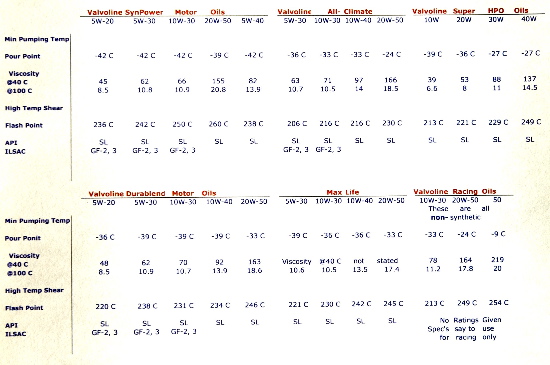 aehaas | |||
| Dave Tegeler (Aeroengineman)
New member Username: Aeroengineman Post Number: 16 Registered: 10-2003 |
I use the Valvoline Full Synthetic 5W-40 in my '97 F355 - It is the most perfect match I could find for the Shell Helux Ultra. As you can see in the attachment - Its measurements are very close to those quoted in the attachment below in the prior posting.
| |||
| Ali Haas (Aehaas)
Junior Member Username: Aehaas Post Number: 178 Registered: 5-2003 |
What I think is that you should use the weight of oil that gives you around 70 - 80 PSI at 6,000 RPM in your engine. For my 575 M 20W oil is still too thick for around town temperatures but even I am chicken to go any lower at this time. There- I said it. That Shell Helix Ultra flash point is too low for my liking but they do recommend it so I suppose it is OK. I asked Shell (Graig Raley, chief tech in Huston, TX) what they use in F 1 cars. He said it was proprietary and they would not tell me. I am certain it is very different. Actually he stated that he could in fact tell me but then he would have to kill me. ali | |||
| Mitch Alsup (Mitch_alsup)
Intermediate Member Username: Mitch_alsup Post Number: 1198 Registered: 4-2002 |
Shell Helix Ultra 5W40 Has cold start 76 cSt, hot running 13.8 cSt, but only 206dC flash point. This is close to the Ferrari recommended oil (10W40::'95 F355 users manual) and may well indeed be the Ferrari recommended oil for F355/F360 (at the current point in time). Ali: SHU With a hot running number of '13.8', does this in any way persuade you that '10' may not be the ideal number for these engines? if not why? | |||
| Ali Haas (Aehaas)
Junior Member Username: Aehaas Post Number: 174 Registered: 5-2003 |
Mitch, Great observation. It goes along with the fact that many synthetic oils act like multi viscosity oils without VI improvers. However, In the Redline specifications they do not recommend the use of racing single weight oils for every day use. This has to do with the additives, or lack of them. ali | |||
| Mitch Alsup (Mitch_alsup)
Intermediate Member Username: Mitch_alsup Post Number: 1193 Registered: 4-2002 |
Ali: Why is it that Redline 30WT Race oil has A) reletively low viscosity at 40C (64 cSt), yet B) maintains good viscosity at 100C (9.8 cSt) and C) has the highest flash point (270dC) of any oil on the charts? Perhaps this is the best oil on the chart? | |||
| Ali Haas (Aehaas)
Junior Member Username: Aehaas Post Number: 171 Registered: 5-2003 |
Interestingly, if I remeber the SAE specs correctly the 0 for a 0W-20 or 30 is lower than the 0 for the 0W-40 or 50. Do not ask me why they set it up this way. It goes back to the fact that we have to look at the data, not the numbers on the can of oil. aehaas | |||
| dave handa (Davehanda)
Intermediate Member Username: Davehanda Post Number: 2017 Registered: 5-2001 |
ali, Thank you for the correction; my main point is that since they are all are supposed to be 0W at the bottom end, shouldn't they have similar characteristics at 40C? Unfortunately, they have surprising differences, and thus one 0W cannot be considered the same as another 0W. I guess my next question is, are these oils really meeting the 0W spec if they can differ that much at 40C? | |||
| Ali Haas (Aehaas)
Junior Member Username: Aehaas Post Number: 170 Registered: 5-2003 |
Dave, Your statement that a 0W-30-40-50 oils are all 0 based oil only applies to mineral based motor oils. These are generally 0 based with increasing amounts of viscosity improvers added. The makeup today is different than in the past however. Synthetic oils are often of a single oil viscosity that behaves as a multi-viscosity oil but does not require the VI improvers for that characteristic. ali | |||
| Ali Haas (Aehaas)
Junior Member Username: Aehaas Post Number: 169 Registered: 5-2003 |
If 10 is the right number, then 40, 80 or 120, as at startup temperatures are all way too thick. Therefore, 0W-X should always be used instead of 5, 10 or 20W-X. I used X=10 as an example. X is whatever your engine requires to give you the pressure range at your operating range / temperatures. It seems that all the owners handbooks I have seen give a range of 75 - 90 PSI at 6,000 RPM at operating temperature. Every person I have ever spoken to runs over the maximum rated pressure and thinks nothing of it yet nobody runs under the minimum. Somehow more is always better. This is just not true. aehaas | |||
| Mitch Alsup (Mitch_alsup)
Intermediate Member Username: Mitch_alsup Post Number: 1191 Registered: 4-2002 |
Question: Why is '10' the right number for a warm engine? (As opposed to say '8', or '15') | |||
| Ali Haas (Aehaas)
Junior Member Username: Aehaas Post Number: 168 Registered: 5-2003 |
All data is from this year. aehaas | |||
| DGS (Dgs)
Member Username: Dgs Post Number: 387 Registered: 5-2003 |
What year were these samples taken? I gather that oil formulas change frequently. (Mobil recalled their 0W-30 a few years back, when the new formula had a mistake in it.) I saw a similar study that rated the Valvoline Synth as very good, but that study was old enough that one of the better dino oils was Shell "Fire&Ice". (Anyone else old enough to remember that oil?) | |||
| dave handa (Davehanda)
Intermediate Member Username: Davehanda Post Number: 2007 Registered: 5-2001 |
Ali, I really appreciate all your explanations and information, it has really helped me to make a more informed choice on lubricants. Obviously, little can be gained from reading the bottle, it is in the detailed spec sheets that the "real" information is held. | |||
| Ali Haas (Aehaas)
Junior Member Username: Aehaas Post Number: 167 Registered: 5-2003 |
I have to tell you that early on I figured out that the numbers on that can of oil are just not right. You really have to look at the actual data to make an informed choice. Also note that the Pennzoil 100W gear oil is the same thickness as 30W engine oil. Go figure. aehaas | |||
| Mark Eberhardt (Me_k)
Member Username: Me_k Post Number: 772 Registered: 5-2002 |
I just made the switch from mobil 15w50 to castrol 5w50...I just can't get myself to give up the 50 part.... | |||
| Hans E. Hansen (4re_gt4)
Intermediate Member Username: 4re_gt4 Post Number: 1730 Registered: 4-2002 |
I'm kinda eyeing the Mobil 1 0W40 as a replacement for the 15W50. | |||
| dave handa (Davehanda)
Intermediate Member Username: Davehanda Post Number: 2003 Registered: 5-2001 |
Ali, I see a pretty wide variation in the viscosity at 40c for the 0w-X oils....if they are all 0w base, then shouldn't their viscosity rating at 40c be closer grouped together? I see one at 43 and one at 80. In fact some of the 5w are lower than the 0w.... | |||
| vince porto (Vince)
New member Username: Vince Post Number: 17 Registered: 3-2002 |
Some definitions may be helpful.... Flash Point: The lowest temperature at which the vapor of a combustible liquid can be made to ignite momentarily in air. Bubble Point: Bubble point, or saturated liquid temperature, is the temperature at which it begins to evaporate. Or in other words, the temperature where the first bubble of vapor appears in the liquid. Bubble point is equivalent to boiling point for single component liquid. Pour Point: Temperature at which materials possess a defined degree of fluidity. One particular method of determining pour point involves recording the times of efflux of a specified volume of the molten product through an orifice of standard dimensions. From the figures thus obtained, it is possible to arrive at a temperature which permits a standard volume of product flow through the orifice in a specified time. This temperature is the pour point. Rgds, Vince | |||
| Skip Williamson (Darolls)
Junior Member Username: Darolls Post Number: 135 Registered: 7-2003 |
>Now note the vs at 100 C (104 F). Ali- That's 212 F. | |||
| Ali Haas (Aehaas)
Junior Member Username: Aehaas Post Number: 166 Registered: 5-2003 |
Hans, That may be one reason the transmissions are doing better with the 75W-90 NS. It is thinner, easier to shift. ali | |||
| Hans E. Hansen (4re_gt4)
Intermediate Member Username: 4re_gt4 Post Number: 1729 Registered: 4-2002 |
One interesting point is that Redline 75W90 and 75W90NS have different cold viscosities. | |||
| Mr. Doody (Doody)
Intermediate Member Username: Doody Post Number: 1920 Registered: 11-2001 |
neat tables, aehaas! this partially explains why the 550s eat oil - the SHU 5W40's flash point is relatively quite low. doody. | |||
| Paul Bianco (Paulie_b)
Member Username: Paulie_b Post Number: 999 Registered: 1-2003 |
thanks for the research. I use 15W-50 Mobil 1. | |||
| Ali Haas (Aehaas)
Junior Member Username: Aehaas Post Number: 165 Registered: 5-2003 |
This list is handy. For example, if you have a higher oil consumption then you may want to go to an oil that has a higher flash point. Redline motor oil would be a good choice if you are looking for multi viscosity ranges. It will evaporate less at higher temperatures. Use Redline 5W-30 instead of Castrol GTX 5W-30. aehaas | |||
| Ali Haas (Aehaas)
Junior Member Username: Aehaas Post Number: 164 Registered: 5-2003 |
I tried to get some of my data up here. There are a few things of note. Compare for example the motor oil viscosities (I will abbreviate with - vs) at 100 C (212 F). Most range from around 8 to 18. This is the operating vs of the engine / oil combination. Now note the vs at 100 C (104 F). They range from 40 to 160 or more. In a perfect world the vs would always be a constant regardless of the temp. and would be say 10 or 11 for the average 30W oil. You would want your oil to have a vs of 10 when the outside temp. was 32 F or 100 F. Once the engine is warmed up the vs is 10. Your engine/oil cooling system keeps the temp. constant at all times and the oil is always at 10. If your engine requires 10 then it requires 10 at all times. This is why I keep telling people to use the lowest first number, then the appropriate second number for your specific needs. 0W-X is what everybody should be using. Never 5W-X or 10W-X and certainly never 20W-X. If you need an oil that is 50W at operating temperature such as Castrol 20W-50 as many are using, then you are causing a lot of wear on startup. The oil has a vs of 17.6 at 212 F yet has a vs of 153 at 104 F, probably over 200 at 70 or 80 degrees F. Here I say use something as Mobil 1, 15W-50 or Pennzoil Synthetic 5W-50. They both have a vs of 17 to 18 when hot but are much thinner on startup. More fun... Let me compare the Shell Helix 5W-30 to the Helix 15W-50. At startup, 104 F, the 15W-50 is 80 centistokes thicker. At operating temperature, 212 F, the difference is only 5 centistokes (cs). Please note that the scale is relative. Even though one has a vs of 12 and the other has a vs of 18 it is not 50 percent thicker. It is only 5 cs thicker. This is in fact a very small difference. See some of my older posts. �nuff for now... 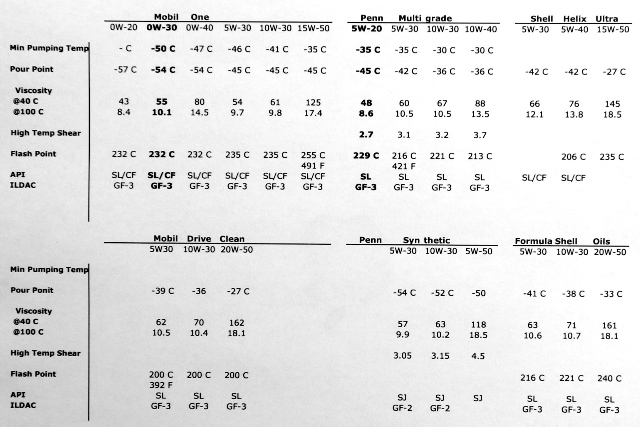 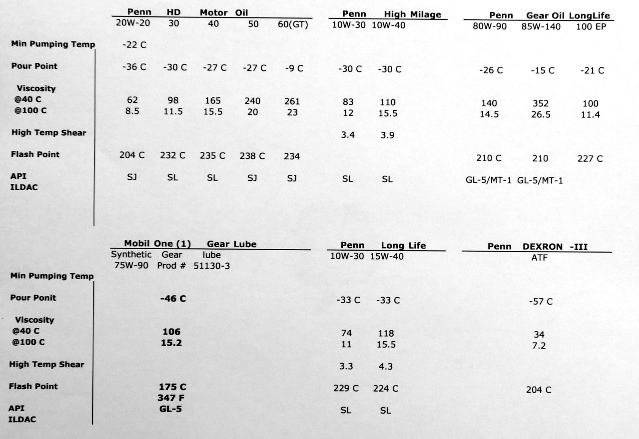 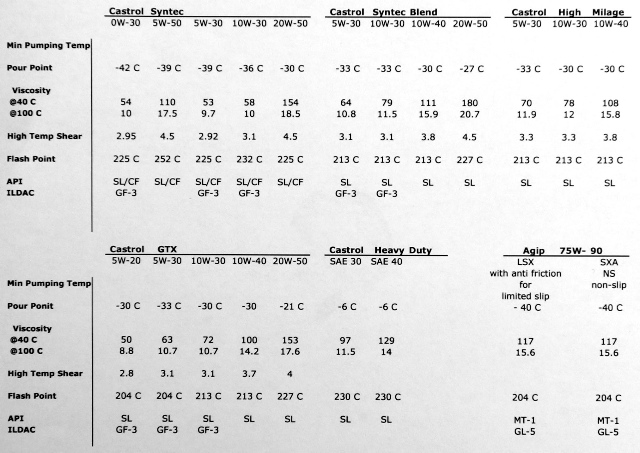 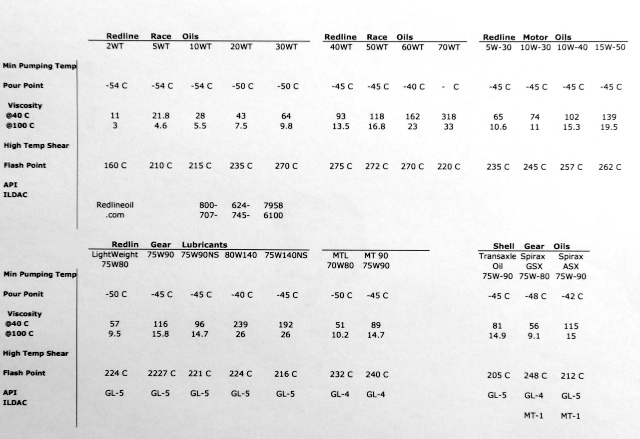 aehaas |